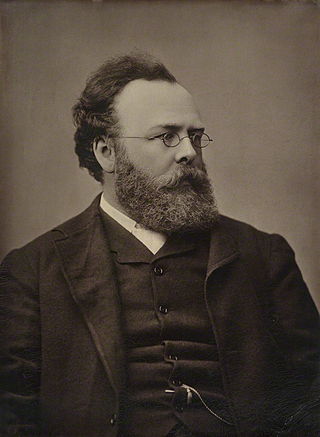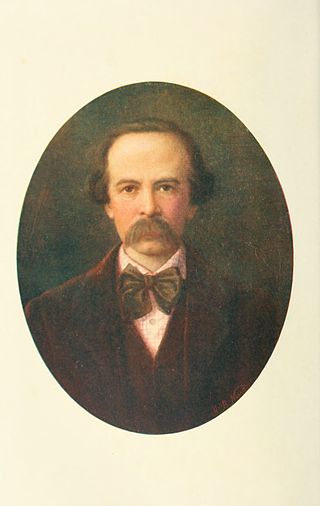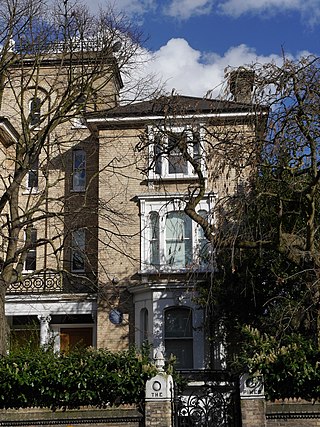
Bloomsbury is a district in the West End of London. It is considered a fashionable residential area, and is the location of numerous cultural, intellectual, and educational institutions.

Robert Williams Buchanan was a Scottish poet, novelist and dramatist.

St Anne and St Agnes is a church located at Gresham Street in the City of London, near the Barbican. While St Anne's is an Anglican foundation, from 1966 to 2013 it was let to a congregation of the Lutheran Church in Great Britain.

Theodore Watts-Dunton, from St Ives, Huntingdonshire, was an English poetry critic with major periodicals, and himself a poet. He is remembered particularly as the friend and minder of Algernon Charles Swinburne, whom he rescued from alcoholism and drug use and persuaded to continue writing.
St Margaret Lothbury is a Church of England parish church on Lothbury in the City of London; it spans the boundary between Coleman Street Ward and Broad Street Ward. Recorded since the 12th century, the church was destroyed in the Great Fire of London in 1666 and rebuilt by the office of Sir Christopher Wren. St Margaret Lothbury still serves as a parish church, as well as being the official church of five Livery Companies, two Ward Clubs and two Professional Institutes. It also has connections with many local finance houses, all of which hold special services each year.

St Lawrence Jewry next Guildhall is a Church of England guild church in the City of London on Gresham Street, next to Guildhall. It was destroyed in the Great Fire of London in 1666, and rebuilt to the designs of Sir Christopher Wren. It is the official church of the Lord Mayor of London.

St. Mary Staining was a parish church in Oat Lane, northeast of St. Paul's Cathedral, in the City of London. First recorded in the 12th century, it was destroyed in the Great Fire of London in 1666 and not rebuilt.
Walter Hindes Godfrey, CBE, FSA, FRIBA (1881–1961), was an English architect, antiquary, and architectural and topographical historian. He was also a landscape architect and designer, and an accomplished draftsman and illustrator. He was (1941–60) the first director and the inspiration behind the foundation of the National Buildings Record, the basis of today's Historic England Archive, and edited or contributed to numerous volumes of the Survey of London. He devised a system of Service Heraldry for recording service in the European War.

St Antholin, Budge Row, or St Antholin, Watling Street, was a church in the City of London. Of medieval origin, it was rebuilt to the designs of Sir Christopher Wren, following its destruction in the Great Fire of London in 1666. The 17th-century building was demolished in 1874.

Ormeley Lodge is a Grade II* listed early 18th-century Georgian house, set in 6 acres (2 ha) on the edge of Ham Common, near to Richmond Park in Ham, London. It is owned by Lady Annabel Goldsmith.

Montrose House is a late 17th-century Grade II* listed building at 186 Petersham Road, Petersham in the London Borough of Richmond upon Thames.

The Pines is a Grade II listed house in Putney in the London Borough of Wandsworth, it was home to the poets Algernon Charles Swinburne and Theodore Watts-Dunton.

Chenies Street is a street in Bloomsbury, London, that runs between Tottenham Court Road and Gower Street. It is the location of a number of notable buildings such as Minerva House, the Drill Hall, and a memorial to The Rangers, 12th County of London Regiment. North Crescent starts and ends on the northern side of Chenies Street.

Half Moon Street is a street in the City of Westminster, London. The street runs from Curzon Street in the north to Piccadilly in the south.

Homer Row is a street in the Marylebone district of the City of Westminster, London, that runs form Old Marylebone Road in the north to the junction of Crawford Place and Crawford Street in the south.

Poland Street is a street in the Soho district of the City of Westminster, London. It runs from Oxford Street in the north to Broadwick Street in the south. It was named after the "King of Poland" pub, which was renamed in honour of Poland's King John III Sobieski in the heading of a coalition of western armies, crucially defeated the invading Ottoman forces at the 1683 Battle of Vienna. In the eighteenth century, Polish Protestants settled around Poland Street as religious refugees fleeing the Polish Counterreformation.
This is a list of the etymology of street names in the London district of Bloomsbury. The following utilises the generally accepted boundaries of Bloomsbury viz. Euston Road to the north, Gray's Inn Road to the east, New Oxford Street, High Holborn, Southampton Row and Theobald's Road to the south and Tottenham Court Road to the west.

Russia Row is a street in the City of London that runs between Milk Street and Trump Street on the northern side of the former Honey Lane Market. Russia Court, formerly Robin Hood Court, the home of the Russia Company, was once located on the northern side of the street and the City of London School on the south side. The street is thought to have received its name around 1804, shortly before Russia decided to enter the Napoleonic Wars on the same side as Britain. It was damaged by German bombing during the Second World War and has since been completely rebuilt.

Algernon Charles Swinburne was an English poet, playwright, novelist, and critic. He wrote several novels and collections of poetry such as Poems and Ballads, and contributed to the famous Eleventh Edition of the Encyclopædia Britannica.

Rugby Street, formerly known as Chapel Street, is a street in the Bloomsbury district of the London Borough of Camden. It was built between around 1700 and 1721 on land that was given to Rugby School in Warwickshire and now forms part of London's Rugby Estate. Many of its buildings are listed by Historic England such as the grade II The Rugby Tavern. It was renamed Rugby Street in 1936 or 1937. In the post-war period, number 18 was the home to many creative people and the house where Ted Hughes and Sylvia Plath spent their first night together.




















